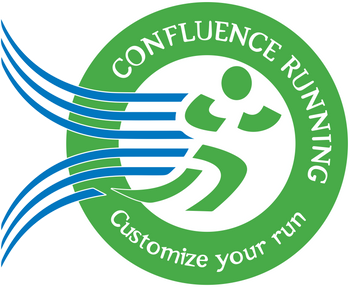Why Run The Mile
Brooks Johnson was one of the best distance coaches in the USA. He coached Stanford University and National Teams. I remember he used to say, “Speed kills …. those who don’t have it." Johnson was coaching runners at the highest level of the sport who wanted to win NCAA, National, and Olympic and World Championships. But his philosophy can be applied to any runner at any level who wants to improve.
There comes a point in any runner’s journey where “just finishing” is no longer the goal. You’ve finished your 5K, 10K, ½ marathon, marathon. Now what? How about getting faster? Setting PR’s? Beating that Age Group Ace who finishes just in front of you every time you race?
To achieve your goals you need speed. A recent article posted on the Confluence Running Beginner’s Running Facebook page suggested that racing a mile might help you run a faster marathon!
Well, yes but so do thousands and thousands of Age Group runners all over the nation in all-comers track meets throughout the winter, spring, and summer. Just check out results posted on the Fingerlakes Runners Club and Triple Cities Runners Club web sites and you will see that, yes, anyone can and should race the mile.
I can tell you from personal experience. I used to be an 800 runner and I loved the mile. I could run 2:00 for the 800 and breaking 5:00 for the mile was a walk in the park. But there was a catch, I was young, real young, and had natural speed in my legs. I started my running career as a cross-country and track runner and had the natural speed of anyone from 14-20+ years old.
Then, I stopped racing on the track, I stopped running short repeats and I lost my speed. So, last fall I decided to go back to my roots and train for and run some 800’s and miles. I admit I’m not as fast as I used to be but I noticed something really cool. When I would go out for an easy 6 miles, what used to feel easy at 7:50-8:00 pace now felt like I was barely moving along at 7:20-7:30 pace!
I’ll tell you what happened - I got some speed back in my legs. You see the key to running to your personal potential is leg turnover- how fast your legs turn over from stride to stride. I was propelling myself along the ground faster than before with less effort because my legs have speed. After 15 years of neglecting that part of my training I actually felt fast again!!!
A lot of my Team Confluence friends will tell you that last fall I swore off any race longer than 5K. I just wanted to race fast (and I have to admit, being ranked #1 in the USA in my AG in the 800 for a few weeks got me excited). But back to the easy runs. I got thinking (as I watched a 13:15 5k runner run his first ½ marathon in 60:51, one of the fastest times ever by an American): Hmmmm maybe I could run a faster ½ marathon because I have this new found speed in my legs!! I mean if I could “jog” 6 miles in under 47:00 on a cold and windy day after a long day on my feet at school, maybe I can run a decent ½ marathon!!!
Coming up March 7 (www.paradedaymile.com) is a 1 mile race down Court and Main Streets right before the Parade! Confluence is bringing back this event from a few years ago for good reason - it’s fun. I know - I’ve done it. Running by thousands of screaming parade goers is a riot.
Bring your friends and sign up - if you’re 21 you get a free beer at the finish! Set a goal to run a mile March 7 and to get there add some speed to your weekly routine. You’ve never done it? It’s easy (ok, it’s NOT easy but figuring out a program is). Keep your mileage where it is (World Class Milers run mega miles, like 100+ per week). So, don’t decrease mileage, just add a couple workouts twice a week.
Warm up, cool down 1 mile, 2 miles, whatever suits you. I recommend hills once a week. Run up and jog/walk down. Over and over as much as you can/want to/have time for. Find a hill- roads, grass, sidewalk, it doesn’t matter. Keep it short (you want speed) 50-100 meters and do it. Or, you can run hilly courses- go out and run how ever many miles you want and make sure you go up and down as many long, short, steep, gradual hills as possible. Lucky me- Endwell is great for that!
Then, once a week try something shorter than you’ve likely done. I think the perfect distance is 300 meters with whatever recovery interval you feel is appropriate for you and your level of fitness. Find a track run 300 repeats.
The time you should run? Honestly, don’t worry about it, you’re new to this plus the weather might not cooperate. But, as a guideline figure out the pace you can do (or think you can do) for a mile. Use one of those running calculators if you have to, but find a time. Let’s say you think you could run 1 mile in 6:00. Now comes the math- divide- 6:00 is 1:30 per 400 and it’s 1:08 for a 300. If we're talking hitting an 8 minute mile, then you're looking at 2:00 per 400 and 1:30 for 300. There you go - easy math.
I do them at 5:00 am - I am very lucky to live on a block that measures 409 meters around and it’s flat. I also live at the bottom of a hill that is about 150 meters long. Lucky me, again.
The point is, you can do them. Your time for the repeats doesn’t matter and do not overdo it. What you’ll notice is that fairly quickly your legs will start moving faster with no extra effort.
If you like it (I LOVE speed work) add in some 200’s and 400’s - all at mile pace.
One other thing that anyone can do, anywhere are 100 meter strides. At the end of your run, you do four or so 100 meter “runs” at about the effort you would race a 5K.
At the end of a workout you should not feel all sore and tired (that’s for Gatorade commercials). You almost feel refreshed, like you just did something good for your body (because you did)!
You’re training your legs to run faster. These workouts WILL make you a faster runner at every distance (including the marathon) and you just might find that you like the shorter races more.
Running and racing is about a lot more than just finishing. It’s about finishing at the limits of your own personal potential be that a ½ marathon in 1:00 or a 2:00. Getting faster is fun and rewarding and completing a tough speed workout is a great feeling.
Change up your running and gain some speed and you can run the classic distance the 1 mile run! See you on Parade Day!!!


